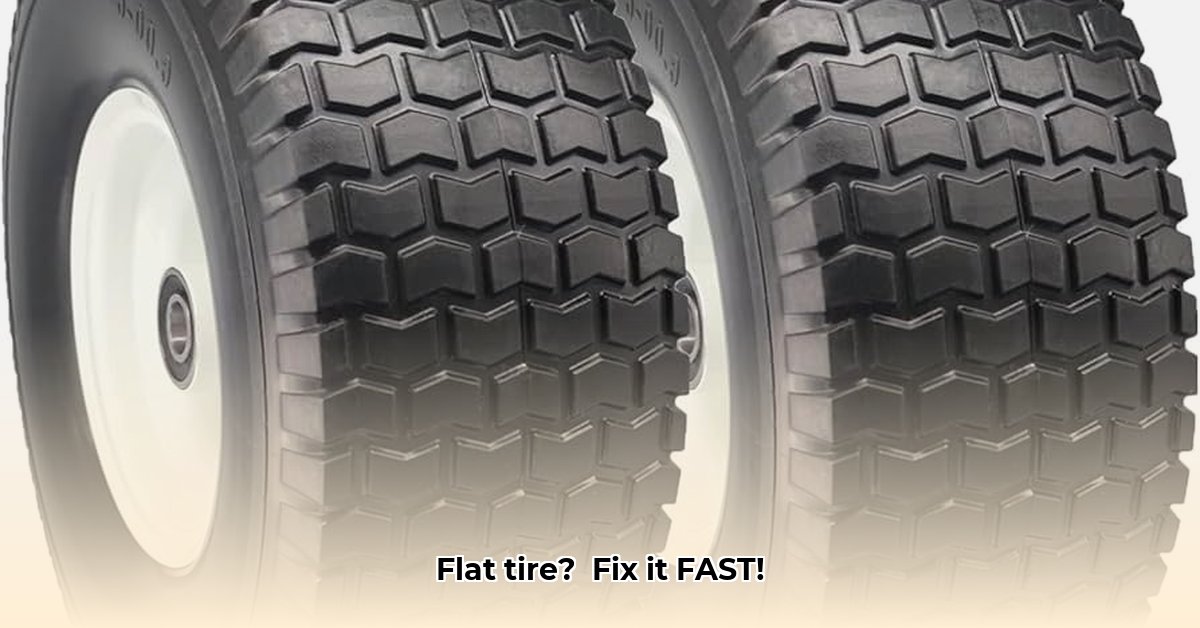
Flat Tractor Tire Repair: A Sustainable Farmer's Guide
A flat tractor tire means downtime, lost productivity, and a hefty repair bill. But what if you could fix it yourself, saving money and getting back to work faster? This guide empowers you to do just that, while contributing to a more sustainable farming operation. We'll cover everything from simple punctures to preventative maintenance, ensuring you keep your tractor rolling and your farm thriving. For more in-depth guidance, check out this helpful resource.
Assessing the Damage: The First Step
Before you start, carefully inspect the tire. Is it a small puncture, a gash, or something more serious? A small hole in the tread is easily patched, but a large tear or sidewall damage likely requires professional help or tire replacement. Remember: Safety first! Always work on a level surface with the tractor's parking brake engaged. Never work under a raised tire or other unstable parts of the equipment.
Step-by-Step Flat Tire Repair: Patching a Small Puncture
This section details patching a small puncture in the tread. For significant damage, consult a professional.
Step 1: Prepare the Area: Clean the area around the suspected puncture thoroughly. Remove all dirt, rocks, and debris using a wire brush.
Step 2: Locate the Leak: Use a soapy water solution (dish soap and water in a spray bottle) to pinpoint the leak. Spray the suspected area; bubbles will indicate the air escape point.
Step 3: Tube Removal (If Applicable): Carefully remove the inner tube from the tire. Take photos or notes to aid reassembly. Handle gently to avoid further damage.
Step 4: Roughen the Puncture Area: Use a fine rasp or sandpaper to slightly roughen the area around the puncture. This helps the patch adhere properly.
Step 5: Apply the Patch: Follow the instructions on your tire patch kit. This typically involves cleaning the area with solvent (provided in the kit) and firmly applying the patch. Ensure complete adhesion.
Step 6: Inflate Cautiously: Gradually inflate the tube, checking frequently for leaks. Use your soapy water solution to detect escaping air.
Step 7: Thorough Inspection: Before reassembly, thoroughly check the entire tube for leaks using the soapy water solution. Finding further leaks now is significantly easier.
Step 8: Reassembly: Carefully reinstall the patched inner tube into the tire, ensuring proper placement.
Step 9: Remount the Tire: Carefully remount the tire onto the rim, avoiding pinching the tube.
Addressing More Severe Damage
For larger punctures or sidewall damage, patching is insufficient. Consider professional repairs like tire liners or retreading. For irreparable damage, tire replacement is necessary. Remember to recycle or repurpose the old tire whenever possible.
The Green and the Greenbacks: Environmental and Economic Benefits
Repairing a flat instead of replacing a tire offers significant economic and environmental advantages. Manufacturing new tires is resource-intensive. Repairing saves money, conserves resources, and reduces your carbon footprint. A new tractor tire costs hundreds of dollars; a simple repair kit costs only a few. By repairing, you divert waste from landfills and align with sustainable agriculture practices.
Did you know that a single new tractor tire can cost upwards of $500? This underscores the significant cost savings of effective tire repair.
Preventative Maintenance: Keeping Those Tires Happy
Regular checks prevent major problems and substantial repair bills.
- Tire Pressure Checks: Check tire pressure weekly (more often in challenging terrain) using a reliable gauge. Underinflation increases puncture risk and tire wear. Refer to your tractor's manual for recommended pressure.
- Visual Inspections: Before each use, quickly inspect your tires for cuts, embedded objects, or damage.
Long-Term Strategies: Investing in Sustainable Tire Management
- Advanced Training: Consider a tire repair course to enhance skills and confidence.
- Dealer Partnerships: Build relationships with local equipment dealers for parts and advice.
Conclusion: Keep Rolling Sustainably
Fixing flat tractor tires is a valuable skill that directly benefits your bottom line and the environment. By following this guide and incorporating preventative maintenance, you can keep your tractor operating efficiently and your farm thriving sustainably. Remember, a small investment in repair can save you hundreds—and contribute to a greener future for farming.
Resources: (Include links to relevant supplier websites for repair kits and training programs here.)